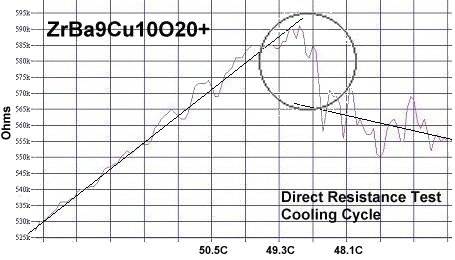
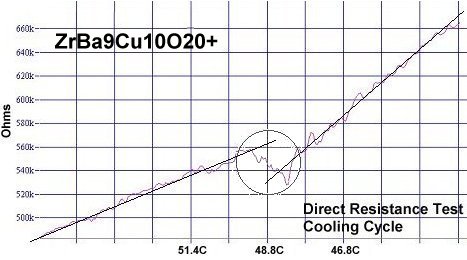


Superconductors.ORG herein reports the discovery of the first room-temperature superconductor to require only 4 elements to synthesize. A small amount of the compound ZrBa9Cu10O20+ has been found to produce a critical transition temperature (Tc) near 49 Celsius (120F) both resistively and magnetically[1]. It is the 27th room temperature superconductor (RTS) discovered to date.
All 26 prior RTS formulations were based on either the X212 or X223 structure[2] and required 5 to 7 different elements. This new discovery - dubbed Zr19A - is based on the F212C structure, which is an elongated version of the YBCO structure. It has a long copper-oxygen chain along its C1 axis and a long barium chain in the C2 axis (see graphic below left). The colinear barium atoms create a high planar weight ratio (PWR) across the oxygen layers interposed with zirconium. Previous research has found a high PWR to be an essential component of high temperature superconductivity.
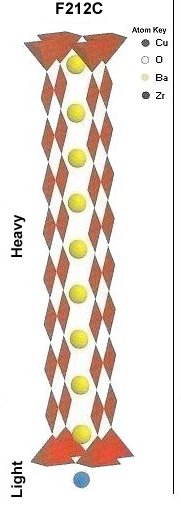
|
At page top are two plots showing sharp resistive transitions near 49C that were produced by this compound. And below is a companion magnetization plot showing a Meissner transition of about 10 milliGauss - also near 49C. Though the volume fraction of the superconductive phase is low, the resistive transitions are strong, due to the non-superconductive bulk being near a Mott transition. (The straight lines represent the average of the data points.) 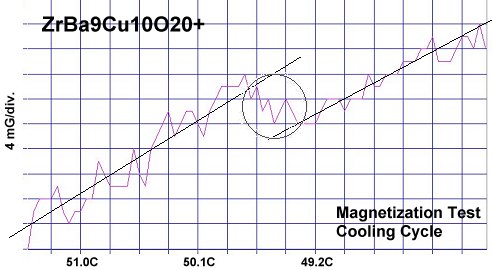 The best performing RT copper-oxides all use a metalloid with a +4 oxidation state in the anion (the "light" region of the graphic). Those metalloids have included silicon, titanium, and manganese. Now that zirconium has also proven viable, hafnium, germanium, selenium and tellurium anions may have the potential to produce room-temperature superconductors as well. This suggests there may be literally hundreds of new RTS combinations awaiting discovery. |
The below graph of known copper-chain superconductors illustrates the correlation between planar weight ratio and Tc in these materials. It also confirms the strong influence that dielectric constant (K) has in promoting Tc. Yttrium-oxide has a Kappa of 10 to 15 and tellurium-oxide is between 10 and 25. But tantalum-copper-oxide is an order of magnitude higher at 125, raising its position well above the curve.
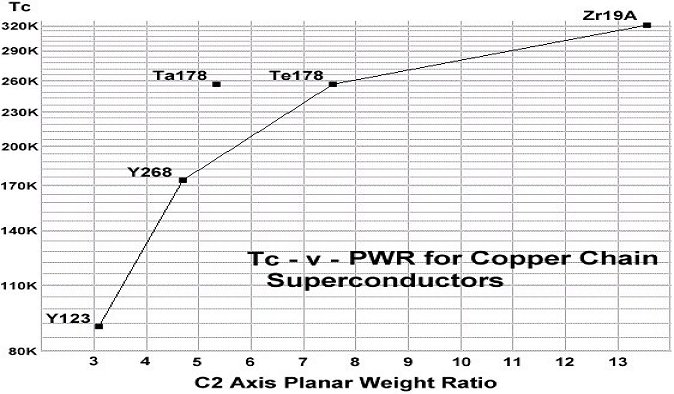
In order to maximize formation of the F212C structure, ZrBa9Cu10O20+ was synthesized using the layer cake method, as shown below. The pellet had approximately 100 interference layers. And, even using this layering technique, the volume fraction is low, requiring very sensitive test equipment.
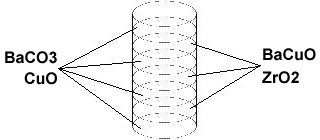
Stoichiometric ratios of the below chemicals were used for the ODD layers:
BaCO3 99.95% (Alfa Aesar) 9.66 grains (decomposes to BaO during calcination, releasing the carbon as CO2)...and the below ratios for the EVEN layers.
BaCuO 99.9% (Alfa Aesar) 3.03 grainsThe chemical precursors were pelletized at 60,000 PSI and calcined for one hour at 760C and then sintered for 9 hours at 880C. Lastly the pellet was annealed for 10+ hours at 500C in flowing O2. Temperature was determined using an Omega type "T" thermocouple and precision OP77 DC amplifier. The magnetometer employed twin Honeywell SS94A1F Hall-effect sensors with a tandem sensitivity of 50 mv/Gauss.
RESEARCH NOTE: The copper-oxides are strongly hygroscopic. All tests should be performed immediately after annealing.
RE-PUBLICATION NOTICE: Elsevier Publishing, dba Elsevier Science, as well as Morris Communications, both print and broadcast divisions, are specifically prohibited from re-publishing any part of this news story.
E. Joe Eck
© 2015 Superconductors.ORG
All rights reserved.
1. Testing temperatures are believed accurate within ± 0.5 degrees C.
2. X is a variable representing integers ranging from 11 to 29.
 BACK to "News" page at Superconductors.ORG
BACK to "News" page at Superconductors.ORG